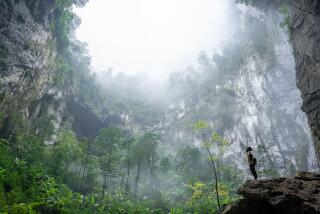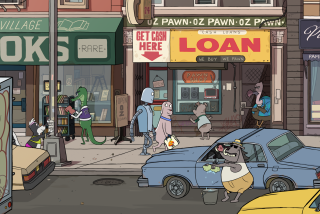Movie Review: ‘Cave of Forgotten Dreams’
Imagine an enormous cave in the Ardeche region of southern France hermetically sealed for tens of thousands of years. Stumbled upon in “one of the greatest discoveries in human cultural history,” it turned out to contain things so hypnotically, startlingly beautiful they make your head spin, things so unimaginably ancient and fragile that human entry is close to forbidden. Now, for the first time, we can see inside and luxuriate in the wonders of the “Cave of Forgotten Dreams.”
Evocatively titled by writer-director and narrator Werner Herzog, a filmmaker who seems almost born for this project, “Cave” not only takes us inside the Chauvet cave, home to hundreds of wall paintings and named after the man who led the discovery team on Dec. 18, 1994, it takes us there in 3-D.
As Herzog determined once he entered the cave for the first time, this film’s gratifying use of the third dimension is no gimmicky ploy to hype the box office. Though not a fan of the technology (“You can shoot a porno film in 3-D, but you cannot film a romantic comedy in 3-D,” he told the British film journal Sight & Sound), he viewed it as necessary to capture paintings that made extensive use of the curves and contours of the cave’s undulating walls.
These pictures of 13 species, from horses and hyenas to lions and rhinos, are not just any paintings, they date back as far as 32,000 years and qualify as the oldest cave art ever discovered, just about twice as old as the better-known works at Lascaux, also in France, and Altamira in Spain.
Because the art in those caves has suffered because of the numbers of people allowed in to look, getting permission to film in Chauvet cave — Herzog, cinematographer Peter Zeitlinger and a two-person crew, all confined to a narrow walkway, ended up spending four hours a day there for six days — was an adventure in itself.
It didn’t hurt that France’s minister of culture was a fan of Herzog’s and that the filmmaker offered to work as a state employee (for a fee of one euro) and agreed to let the French government use the footage free in schools.
What the minister, Frederic Mitterrand, recognized was that Herzog, with a passion for strange and unusual subject matter (“Grizzly Man,” “Fitzcarraldo” and numerous others), a penchant for philosophical enquiry and an almost lifelong zeal for Paleolithic cave paintings, was especially well suited to both showing us the caves and getting us to think about them in a variety of ways.
In fact the director, doing an extensive voice-over, can barely contain his enthusiasm as he talks of what it’s like to be inside caverns that once housed voracious cave bears (who left something like 4,000 animal bones behind) but are now so quiet you can literally hear your own heartbeat.
Herzog knows, of course, that the stars of the film are those paintings, not his words, and he returns again and again to key images, understanding that each succeeding glimpse makes us feel more in tune with what we are seeing.
The most confounding thing about these paintings is how good they are by any standard, even today’s. A compelling pride of lions, intent on some unseen prey, and a remarkably fluid and lifelike group of horses’ heads look, as one expert says, “as if they were done yesterday.”
Though “Cave” has random Herzogian elements that come out of nowhere — a master perfumer asked to comment on Paleolithic air, a glimpse of albino crocodiles at a nearby nature park — the director is excellent at contextualizing these venerable wall paintings, at discussing them with a variety of scientists in a way that allows us to think about them with a perspective we otherwise might not have.
For one thing, Herzog never lets us forget that because they were painted at a time when Paleolithic man was slowly taking over from the Neanderthals, these paintings in a sense represent the birth of the modern human soul, proof of how venerable and intrinsically human the artistic impulse is. “It’s quite evident that it is us,” the director has said. “It is us 32,000 to 35,000 years ago.”
On the other hand, the director is insistent that because of how enormously old these paintings are, a length of time he frankly calls “unimaginable to us,” it is quite impossible to understand what was on the minds of these image makers. If the thoughts of modern-day Aborigines of Australia are any guide, as Herzog believes they are, these artists likely did not think they were being creative as we know the word but rather felt in touch with some kind of elemental life force.
But even if we’ll never know what these people were thinking, that doesn’t get in the way of the profound feelings viewing these images awakens in us. It’s a privilege and a pleasure to be present in a sacred space where the human and the mystical effortlessly intertwine, and we are in Werner Herzog’s debt for that great gift.
More to Read
The biggest entertainment stories
Get our big stories about Hollywood, film, television, music, arts, culture and more right in your inbox as soon as they publish.
You may occasionally receive promotional content from the Los Angeles Times.











